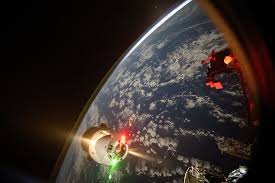Autonomous Docking Systems: How SpaceX’s Crew Dragon Achieved Precision at the ISS

International Space Station – March 16, 2025
At precisely 12:04 a.m. EDT on 3/16/2025, SpaceX’s Crew Dragon Endurance docked with the International Space Station (ISS), a feat of engineering that brought Crew-10 to the orbiting lab and showcased the cutting-edge precision of autonomous docking technology. This moment—34th in the Dragon spacecraft’s history of ISS rendezvous—delivered NASA’s Anne McClain, Nichole Ayers, JAXA’s Takuya Onishi, and Roscosmos’ Kirill Peskov to relieve astronauts Sunita Williams and Butch Wilmore after their 284-day stay. Behind this seamless connection lies a sophisticated autonomous docking system (ADS), a marvel that has redefined spaceflight with pinpoint accuracy and reliability.
The Precision Edge: Millimeters Matter
SpaceX’s Crew Dragon employs an ADS that achieves alignment within 10 centimeters (about 4 inches) of its target, thanks to 16 Draco thrusters firing with surgical precision. These small but mighty engines, each generating 90 pounds of thrust, execute a series of burns to position the spacecraft along the ISS’s docking axis. During the Crew-10 approach, Endurance traveled at 17,500 miles per hour, yet slowed to a mere 0.1 meters per second (0.33 feet per second) for final docking—a testament to the system’s control, honed over 10,000 simulated approaches in SpaceX’s neural network training.
The secret sauce? A blend of LIDAR (Light Detection and Ranging) and advanced optical sensors, paired with relative GPS, allows the Dragon to “see” the ISS with millimeter precision. Unlike the Soviet Igla system of 1967, which pioneered automated docking with a 200-meter accuracy range, Dragon’s modern tech reduces errors by orders of magnitude. Posts on X have noted this leap, with one user highlighting how “neural networks and laser rangefinding” outstrip the radar guidance of NASA’s Gemini program in 1966, which managed docking within a 7-meter tolerance.
A Legacy of Innovation
The Crew Dragon’s ADS builds on decades of spaceflight evolution. The Apollo guidance computer’s Kalman filtering algorithms—first used in 1969 to land humans on the Moon—laid the groundwork for today’s real-time navigation. SpaceX adapted this with AI-driven software, enabling Endurance to autonomously adjust its trajectory during its 28-hour chase from launch on 3/14/2025 at 7:03 p.m. EDT to docking. The system’s six-degree-of-freedom control (pitch, yaw, roll, and three-dimensional movement) ensures it aligns perfectly with the ISS’s International Docking System Standard (IDSS) port, a 31-inch-wide passage for crew and cargo.
Since its first uncrewed test on 3/2/2019 (Demo-1), Dragon has docked autonomously 34 times—10 crewed and 24 cargo missions—delivering over 500,000 pounds of supplies to the ISS across its lifespan. The Crew-10 docking, at 260 miles above the Atlantic, was no exception, with NASA reporting a flawless link-up to the Harmony module’s forward port, completed in under 40 minutes from approach to hard capture.
Numbers That Tell the Story
-
Speed and Scale: The ISS orbits at 17,500 mph, yet Dragon’s ADS slows it to 0.1 m/s for docking, a 175,000-fold reduction in velocity.
-
Reliability: Of SpaceX’s 34 Dragon dockings, 100% have succeeded autonomously, a record unmatched by manual Soyuz relocations (19 since 2000).
-
Capacity: Designed for seven, Crew Dragon typically carries four astronauts, as with Crew-10, leaving room for 500 pounds of cargo beneath its seats.
Beyond the ISS: A Lunar Leap
This technology isn’t just for low Earth orbit. SpaceX’s Starship, eyed for a Mars launch in 2026, adapts the Dragon’s ADS for lunar missions under NASA’s Artemis program. Tested at Johnson Space Center in 2024, Starship’s docking system aims to connect with the Orion spacecraft and Gateway station, promising precision for crew transfers 240,000 miles from Earth. The Dragon’s success—clocking over 400 days in space for Endurance alone—offers a blueprint for these ambitions.
The Human Touch in Autonomy
While fully autonomous, Dragon retains manual override options, a nod to astronauts like Crew-10’s McClain, who monitored the approach. “It’s a dance of machine and human trust,” she said post-docking at 1:40 a.m. EDT. This balance echoes the Demo-2 mission in 2020, when Bob Behnken and Doug Hurley tested manual controls, ensuring the system’s versatility.
Social media buzzed with awe. “Dragon’s docking at 12:04 a.m. EDT was like threading a needle in space,” one X post read, while another marveled, “AI has cut docking errors from meters to millimeters—SpaceX is rewriting the rules.”
As Crew-10 settles in and Williams and Wilmore prep for their 3/19/2025 return, the Crew Dragon’s ADS stands as a pinnacle of precision—bridging past innovations with a future where autonomous systems may one day dock humanity on Mars.